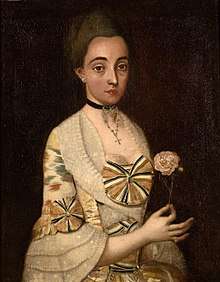Rancho Rodeo de las Aguas
Rancho Rodeo de las Aguas was a 4,539-acre (18.37 km2) land grant in present day Beverly Hills, Los Angeles County, California given to María Rita Quinteros Valdez de Villa in 1838.[1]
.jpg)
Rancho Rodeo de las Aguas (Ranch of the Gathering Waters), is named for the streams that emptied into the area from out of the canyons of the Santa Monica Mountains above it, the Cañada de las Aguas Frias (Glen of the Cold Waters, now Coldwater Canyon) and Cañada de los Encinos (Glen of the Green Oaks, now Benedict Canyon).[2][3][4]
History
Maria Rita Valdez was a granddaughter of Luis Quintero one of the original settlers of Los Angeles. Maria was married to Spanish colonial soldier, Vicente Fernando Villa (–1841).

With the cession of California to the United States following the Mexican–American War, the 1848 Treaty of Guadalupe Hidalgo provided that the land grants would be honored. As required by the Land Act of 1851, a claim for Rancho Rodeo de las Aguas was filed with the Public Land Commission in 1852,[5] and the grant was patented to Maria Rita Valdez at 4,449 acres (18 km2) in 1871.[6]
The rancho was sold in 1854 to Benjamin D. Wilson and Major Henry Hancock. Hancock later sold his share to William Workman.[7] In 1868 Edward Preuss, purchased over 3,600 acres (15 km2) for the development of a city to be known as the "Town of Santa Maria". Lots were platted of about five acres each, but dry weather came and the land reverted to the sheep.[8]
The land next passed into the hands of Henry Hammel and Andrew H. Denker, owners of the United States Hotel at Main and Market Streets in Los Angeles, and became "one vast field of lima beans", supplying the culinary needs of the owners' Hotel. The bean fields survived until 1900 when the land was sold to Burton E. Green of the Amalgamated Oil Company for oil development. After drilling many unproductive wells, they reorganized as the Rodeo Land and Water Company in 1906.[9][10]
See also
- Ranchos of Los Angeles County, California
- Rodeo Drive
References
- Ogden Hoffman, 1862, Reports of Land Cases Determined in the United States District Court for the Northern District of California, Numa Hubert, San Francisco
- 1900 USGS topographic map
- Map of old Spanish and Mexican ranchos in Los Angeles County
- U.S. Geological Survey Geographic Names Information System: Rancho Rodeo de las Aguas
- United States. District Court (California : Southern District) 371 SD
- Report of the Surveyor General 1844 - 1886 Archived 2013-03-20 at the Wayback Machine
- Marc Wanamaker (2005) Early Beverly Hills, Arcadia Publishing, ISBN 0-7385-3068-9
- Beverly Hills history Archived 2009-03-27 at the Wayback Machine
- David Weddle (2003) Among the Mansions of Eden: Tales of Love, Lust, and Land in Beverly Hills, HarperCollins Publishers, ISBN 978-0-06-019817-6
- History of Beverly Hills
I think Mariá Rita Quinteros Valdez de Villa was painted by Ignacio Maria Barreda 18 century
External links
- Exterior view of an adobe on the Hammel and Denker ranch, formerly Rancho Rodeo de Las Aguas in Beverly Hills, 1920